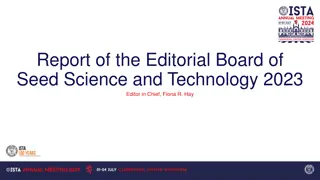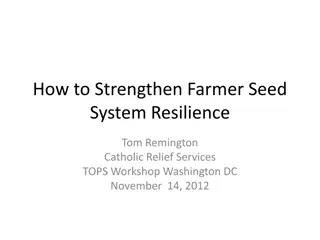Canadian Seed Trade Association Overview and Regulations
The Canadian Seed Trade Association (CSTA) plays a vital role in seed innovation and trade, focusing on open trade, increased investment in innovation, and industry-wide voice. The association follows specific regulations in Ontario related to neonicotinoids and pesticides. These regulations are driven by various factors such as public pressure and government objectives, impacting corn and soybean cultivation. CSTA's mandate emphasizes fostering seed innovation and trade to grow for the world.
Download Presentation

Please find below an Image/Link to download the presentation.
The content on the website is provided AS IS for your information and personal use only. It may not be sold, licensed, or shared on other websites without obtaining consent from the author.If you encounter any issues during the download, it is possible that the publisher has removed the file from their server.
You are allowed to download the files provided on this website for personal or commercial use, subject to the condition that they are used lawfully. All files are the property of their respective owners.
The content on the website is provided AS IS for your information and personal use only. It may not be sold, licensed, or shared on other websites without obtaining consent from the author.
E N D
Presentation Transcript
Canadian Seed Trade Association Seed Treatment and Environment Committee December 6, 2016 Chicago, Illinois Dave Carey Director, Government Affairs and Policy dcarey@cdnseed.org Growing for the World/ Une Croissance Ax e sur le Monde www.cdnseed.org
Overview 1. About CSTA 2. Ontario Regulations 3. Quebec Regulations 4. Federal Reviews: Neonics Fungicides Growing for the World/ Une Croissance Ax e sur le Monde
About CSTA Formed in 1923 132 seed company members 16 member Board of Directors 50 crop kinds All aspects of seed All company sizes All 3 production systems One member one vote Growing for the World/ Une Croissance Ax e sur le Monde
CSTA Mandate Vision: Growing for the World Mission: To Foster Seed Innovation and Trade Strategic Goals: 1. Open Trade 2. Increased Investment in Innovation 3. Industry Wide Voice 4. Efficient Regulatory System 5. Stakeholder and Public Perception of Innovation and Agriculture Growing for the World/ Une Croissance Ax e sur le Monde
Ontario Regulations Based on 2014 election promise Liberal Majority Desire to be first to regulate in N. America o Europe as example Regs impact corn and soybeans only Neonics Only Regs result of Perfect Storm of Bee loses in 2012: o Very warm, dry and early spring - bees foraging early o Adoption of air planters
Ontario Regulations (2) Ideology over science Intense public pressure from activist NGO groups Extensive, one sided media coverage Driven by the MOECC rather than OMAFRA Objectives-Aspirational Goals: 80% reduction in acres of neonic treated corn and soybeans by 2017 15% honeybee overwinter loss by 2020 Set a precedent
Class 12 Regulatory Requirements Pesticides are approved by PMRA federally and scheduled provincially In Ontario Neonic treated corn and soybean seed is classified as a Class 12 under the Pesticides Act o Treated seed is classified as the pesticide o Applies to imidacloprid, thiamethoxam and clothianidin o Planting Class 12 is considered an extermination
Scope of Ontario Regulations Corn: Corn refers to grain or silage corn Does not include popping corn, sweet corn or corn used for seed production Soybeans: Does not apply to seed for certified seed production Does not apply to research plots
Regulated Parties Vendor: Sells, offers to sell or transfer corn and soybean seed treated a neonic. Require 5 year license Vendors Include: Seed companies treating with a neonic via own plant or through 3rd party processor Retailer purchasing seed, treating seed using their own third party treater and reselling treated seed to a farmer Retail purchasing and reselling treated seed that does not have a treater Vendors Do Not Include: Direct-to-farm (qualifying seed dealers) Sales reps including retail dealers Custom Seed treaters
Vendor Obligations Treated Seed Vendor License cost $300 valid 5 years and must follow all regulatory requirements Provide list of all Class 12 pesticides available for sale by July 31st annually o Corn hybrids and soybean varieties Disclose in all product advertising whether seed being sold are Class 12 pesticides and which active they contain and o Including that non-Class 12, fungicide only or bare seed are available
Vendor Obligations (2) Obtain required grower documentation before sale Retain grower required documentation for 4 years Report the summarized sales of Class 12 pesticides and non neonic treated corn and soybeans seed to MOECC by October 31st annually Forward completed pest assessment reports to OMAFRA by October 31st annually Ensure Sales Reps have received training and have proper identification
Grower Obligations Up to August 31, 2016: 1. 50/50 self declaration 50% of acres can be planted with Class 12 2. Self Pest Assessment or Damage Assessment by Field: o Self assessment valid for 12 months o Assessment done spring 2016 = 2017 planting o Fungicide only = no paperwork o Fungicide + non-neonic insecticide = no paperwork or restrictions Vendor and Sales Rep must track non neonic sales
Grower Obligations (2) August 31, 2016 August 2017: 1. IPM Certificate Number 2. IPM Declaration Form 3. Pest Assessment or Damage Assessment by Field: o No 50/50 self declaration o Do not need IPM number if using custom planter but pest assessment still required o Self assessment good for 12 month Spring 2016 for Planting 2017 o Fungicide only = no paperwork o Fungicide + non-neonic insecticide = no paperwork or restrictions
Grower Obligations (3) August 31, 2017 and beyond Same as previous slide except: o By county 3rd Part Professional Pest Advisor Assessment o Required every 3 years o Self assessment or 3rd party assessment every year o Fungicide only = no paperwork o Fungicide + non-neonic insecticide = no paperwork or restrictions
Industry Impact Great deal of confusion, anger and frustration. Significant education still required Paperwork and record keeping is very onerous, some smaller companies struggling to manage the HR requirements Regulations are very hard to interpret and therefore comply with GFO sued the Ontario Government but lost at the Superior Court level
CSTA Action Participated in many government WGs and Meetings Participated in consultations-drafted submissions o Engaged members to participate and reach out to local policy makers Testified at Senate Committee x 2 Implemented BMPs for planting treated seed Adopted use of Fluency Agent members distributed Creation of AAFC Bee Health Roundtable CSGA-CSTA Guide to Treated Seed Stewardship: Best Practises for the Safe Handling, Storage, Transportation, Use, and Disposal of Treated Seed
Quebec Government has had an aspirational goal of reducing pesticide use as a goal for several years Water and soil of greater concern than pollinators There has been work done to create a database of high-risk pesticides . CLC members have been active on this file December 12th there is a stakeholder meeting in Quebec City where we expect a regulatory announcement to be made
Quebec (2) Increased monitoring of water ways for pesticide residues Increased monitoring of residues on fruits and vegetables (and this by source; ie, domestic or imported fruits and vegetables) Additional funds for ag extension services by the province Studying options to track pesticide sales in QC, particularly neonics Increased support for organic production Requiring prescription from a certified agronomist for the use of plant protection products
Federal Reviews PMRA Timelines of cyclical re-evaluations of Neonic Underway: Imidacloprid cyclical re-evaluation Human health and environmental assessment (excluding pollinators) Expected proposed decision (for consultation): Nov-Dec 2016* Expected final decision: December 2017 Clothianidin and Thiamethoxam cyclical re-evaluation Human health and environmental assessment (excluding pollinators) Initiated: November 2016 Expected proposed decision: December 2018*
PMRA Timeline for Pollinator Re-Evaluations Imidacloprid pollinator re-evaluation Re-evaluation of Imidacloprid- Preliminary Pollinator Assessment (REV2016-05) Published for consultation January 2016 Expected Proposed decision (for consultation): December 2017 Clothianidin and Thiamethoxam pollinator re-evaluations Preliminary Pollinator Assessments: TBD Expected Proposed decision (for consultation): December 2017
Imidacloprid Preliminary Pollinator Assessment Foliar Applications risk dependent on application timing During bloom application expected to pose risk risk minimized by current labels that restrict during bloom application Post-bloom application not expected to pose risk Pre-bloom application - may pose risk minimal information to date current labels restrict pre-bloom applications for many bee attractive crops Soil Applications minimal risk; potential risk under some conditions May vary with soil type and application timing relative to bloom Minimal risk for most soil applications (e.g., melon, pumpkin, blueberry) Potential risk for some crops under certain conditions (e.g., strawberry, tomato) Seed Treatments risk dependent on exposure route Exposure route: Pollen and nectar through systemic transport throughout plant Negligible risk to bees was indicated Exposure route: Dust generated during planting of treated seed Potential for risk from planting of corn and soybean treated seed Risk reduction measures put in place in 2014.
Proposed Decision to Phase out Imidacloprid Nov. 23rd PMRA host impromptu stakeholder call to announce they are proposing to phase out the use of imidacloprid over 3 years This launched a 90 day public consultation on their proposed decision document The environmental assessment of imidacloprid identified risks to aquatic insects, such as midges and mayflies, which are an important food sources for fish, birds and other animals. In some aquatic environments in Canada, imidacloprid is being measured at levels that are harmful to certain insect populations - PMRA
Proposed Decision to Phase out Imidacloprid The proposed decision on imidacloprid has triggered special reviews of clothianidin and thiamethoxam as well* CSTA has already raised concerns with the Minister of Agriculture and Agri-Food In response AAFC will be hosting a multi-stakeholder forum to discuss the potential impacts: o Full day in Ottawa December 21 The full PMRA release is available here: http://www.hc- sc.gc.ca/cps-spc/pest/part/consultations/_prvd2016- 20/prvd2016-20-eng.php
Update on Thiram and Captan Re-evaluations Proposed re-evaluation decisions for a number of fungicides were published for public consultation earlier in 2016 Thiram: February 2016; consultation ended May 2016 Captan: March 2016; consultation ended July 2016 Final decisions are expected in 2018 (as per published 5 year re-evaluation and special review workplan REV2016-07) Thiram: June 2018 Captan: March 2018 Published documentation will include: o Final registration decision o Summary of the comments and proposals received o PMRA's response to these comments and/or proposals
Questions? dcarey@cdnseed.org























